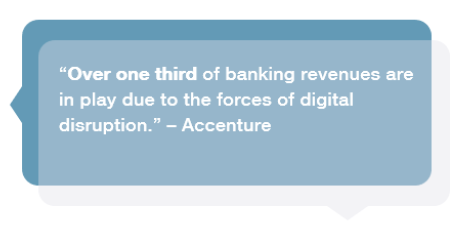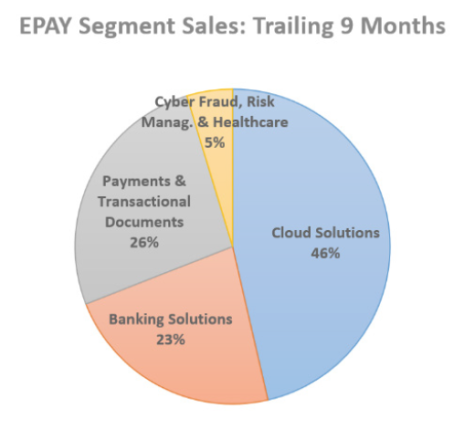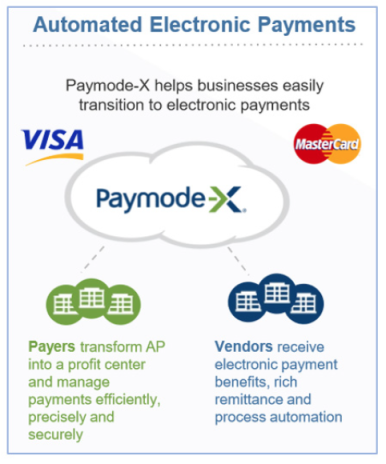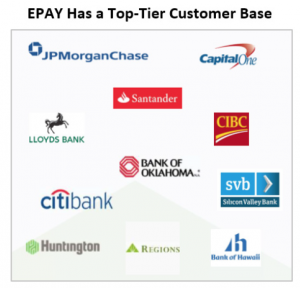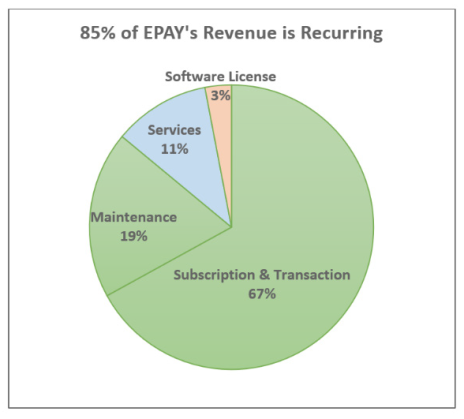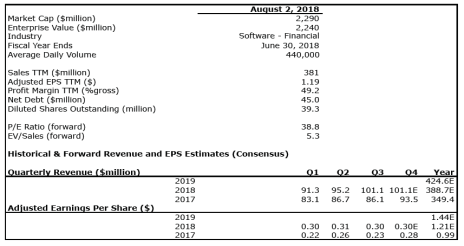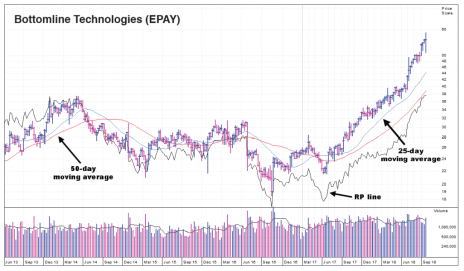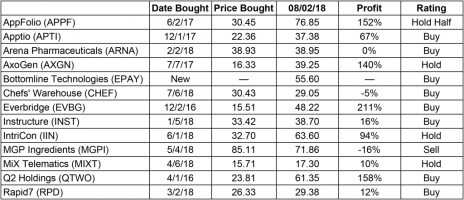With the market on edge we’re going with a slightly larger company than normal with this month’s Cabot Small-Cap Confidential selection. But we’re not being overly conservative. Shares of this software stock have been climbing steadily after a breakout move in May. The reasons? Growth is reaccelerating, profit margins are climbing, and the proportion of recurring revenue is going up.
Cabot Small Cap Confidential 231
[premium_html_toc post_id="155347"]
THE BIG IDEA
The size of the market for electronic business-to-business (B2B) payments is hard to wrap your mind around. In the U.S. alone, it’s estimated that current B2B payment volume tops $20 trillion.
That’s a lot of Benjamins exchanging hands.
Even in such a big market there’s still a lot of room for digital payments to grow. Many businesses continue to do things the old-fashioned way. Over 60% of organizations make half of their payments by paper check. And even though most consumers and businesses prefer to open new accounts through digital channels, most account openings still require a branch visit. Funding those new accounts digitally represents another opportunity for digital transaction growth.
Think about the long-term trend here, and especially about Millennials, who do pretty much everything on a mobile device. Is the trend toward digital payments going to change? Will digital banking channels evaporate in favor of paper-passing? Doubtful.
Let’s go back to checks for a second. Consider how much sensitive information is exposed on that little piece of paper. Address, bank account number, phone number, signature. Most of us would think twice about scribbling all this information on a napkin then passing it to a salesperson. But not when it’s on a check pulled out of that orderly little book!
Industry data shows that over 75% of organizations exposed to payment fraud were victims of check fraud. Another downside is that checks are way more expensive to process than digital payments, costing over 50% more, on average.
Really, the only time to use a check is when you’ve exhausted every other option.
Giving you those options is just one of the initiatives banks are working on by embracing digital payment solutions.
Businesses, in particular, don’t want to mess around. Managers are tasked with streamlining processes, cutting costs, squeezing more profit out of every dollar that comes in the door, and scaling their business up and down quickly to react to market trends. Paper money, along with paper-intensive processes, old ERP systems and manual document filing, flies in the face of these initiatives.
Digital payments, digital messaging and electronic documents are a far more efficient way.
There is a big challenge, however. The banking industry has been held back because the infrastructure many banks use isn’t yet up to snuff to handle the flow of money over digital channels. That means a lot of the banking revenue out there is up for grabs as the market deals with the new digital realities.
Banks and credit unions are now scrambling to get digital solutions up and running. Over time, as these institutions come online, more digital payments are going to flow over the paths of least resistance.
The growth trend should be long and strong as transaction volume grows. We’re not going back to paper money and checks. That makes it an attractive time to invest in companies that sell digital banking solutions and charge transaction fees when money moves over digital payment networks.
We’re taking another step into this market today. We already have some exposure with Q2 Holdings (QTWO), which specializes in digital banking solutions. Today’s Cabot Small-Cap Confidential addition goes deeper and wider into the digital money market by offering a full suite of B2B solutions that are becoming the standard for how businesses and financial institutions move money.
THE COMPANY/PRODUCT
Bottomline Technologies (EPAY) is a $2.2 billion market cap company that is wholly focused on helping businesses pay and get paid. It operates in an extremely complex market where business-to-business (B2B) payment networks literally go every which way but straight. In the face of this complexity, Bottomline is designing simple and secure payment paths that leverage the benefits of cloud-based software and infrastructure.
The company has been pushing hard to develop solutions at scale that address the growing B2B payment market, which is estimated at around $20 trillion. There’s certainly a lot of room to grab market share from industry players. But there’s also a lot of greenspace to grow into by simply displacing paper payments. Industry data shows that 63% of businesses still make 50%, or more, of their payments by paper check.
Bottomline’s customers span all industries, but are mostly concentrated in banking, financial services, insurance and healthcare. Customers include Bank of America Merrill Lynch, Citizens Bank, Deutsche Bank, JPMorgan Chase, HSBC, Fidelity Investments, Capital One, and many more.
These customers rely on Bottomline for domestic and international payments, efficient cash management, automated workflows, payment processing, bill review, fraud detection, behavioral analytics and regulatory compliance.
Even though it is relatively small in terms of market cap, Bottomline’s payment processing network has grown to over 385,000 vendors, and the company has processed over $200 billion in payments.
Management says market demand for its solutions, which have been transitioning to a SaaS delivery model, is accelerating. Part of this is due to rising interest rates, part is due to deregulation in the banking industry, and part is due to financial institutions going after new commercial business. Part is also due to demand for solutions sold on a subscription basis, rather than as perpetual licenses. All these factors work in Bottomline’s favor.
That’s not to say the company doesn’t face competition. It does. There are a lot of players out there. But Bottomline’s results show its strategy is working and its products are finding a receptive audience.
This little Portsmouth, New Hampshire-based company is emerging as a major player in the B2B payments industry. Revenue dipped into the low single digits in 2016 and 2017 when it was in investment mode. Now, innovations and cloud-based solutions are bringing double-digit topline growth back.
Analysts expect average annual growth of 10% over the next two fiscal years. The majority (67%) of revenue comes from Software-as-a-Service (SaaS) solutions that are paid for on both a subscription and transaction basis, while an additional 19% of revenue comes from maintenance contracts. That means 85% of revenue is recurring, which makes for a relatively stable and scalable business model. The market is beginning to appreciate this, which is why the stock has been performing well recently.
The Product Lineup
What exactly does Bottomline sell?
I’ll admit there’s nothing too exciting here on a product level. After all, we’re talking about solutions that facilitate electronic payments and transaction settlement between businesses, their vendors and banks. But if you can absorb the big-picture trend, you’ll understand why these are very valuable solutions.
Bottomline breaks its business down into four reportable segments (see pie chart). The biggest are Cloud Solutions, and Payments and Transactional Documents, which collectively generated 72% of revenue and more than 90% of profits over the last nine months.
Banking Solutions generates 23% of revenue, but less than 10% of profits (this trend should improve).
Finally, the Cyber Fraud, Risk Management and Healthcare segment makes contributes 5% of revenue and is not yet profitable.
Cloud Solutions: Settlement Network Solutions, Messaging & Legal Spend Management
Bottomline’s Cloud solutions are used by banks to provide payment, cash management and treasury capabilities to their business customers, as well as solutions used to acquire customers.
Paymode-X: Paymode-X is Bottomline’s cloud-based payment network, which makes it easier for businesses, vendors and their banks to move from paper to electronic payments. Completing that transition helps mitigate fraud risk, automate payments, streamline receivables processes, reduce days sales outstanding (DSO) and generate cost-savings and productivity gains.
The product pitch is that Paymode-X offers cost savings, while also being more efficient and secure. This is a comprehensive settlement network that combines card, ACH, wire and check payments in a single integrated payment file. Scale is a big selling point for this solution. As the network grows, it’s easier to attract new customers since many of their vendors will already be in the network and can be paid electronically on day one. Growth has been steady, and Bottomline is now up to 385,000 vendors in the network. Bottomline is partnered with both Visa and Mastercard to offer Paymode-X with card capabilities.
Financial Messaging: Cloud-based financial messaging solutions leverage the SWIFT global messaging network to allow customers to securely communicate, reconcile and manage the data in financial transactions between banks, both locally and internationally. Messaging solutions help clients avoid the costs of building expensive infrastructure themselves, while still benefiting from a low cost, easy to implement and secure messaging platform. Bottomline processes over 1 million financial messages daily.
Legal Spend Management: These solutions help insurance clients streamline legal invoice management processes and gain insights related to all areas of outside legal spend, including selecting, retaining, paying and analyzing the performance of outside services. With this solution Bottomline has a 98% retention rate and over 150 insurance clients, including Nationwide, Zurich, AIG, Allianz, StateFarm and The Hartford. There are over 13,000 law firms participating in the network as well.
Digital Banking Solutions
Bottomline offers digital payments, cash management and online banking solutions (ACH and international payments, wires, check production, etc.) to banks and credit unions, which, in turn, allow these FIs to win new customers and ultimately become the sole source of all things financial for their clients. Banks get a payments and cash management platform with a mobile-first design and customizable modules, as well as a powerful customer engagement platform with integrated sales and marketing tools. The banks’ commercial customers enjoy the same benefits, along with tools to manage their finances and seamless integration with many of the third-party software solutions they already use. Digital Banking solutions are currently transitioning to a subscription pricing model, which is gradually pushing up their profit margin profile. This is the business that would be most comparable to current portfolio stock, Q2 Holdings (QTWO).
Payments and Transactional Documents
Bottomline’s payments automation and collections platform allows businesses of all sizes to centralize, automate and streamline payments and cash management by department, or across a global organization, thereby reducing costs and risk around their international and domestic payment channels.
Document automation solutions help customers replace paper-based forms, automate labor-intensive accounts payable processing of invoices, and store digital business documents.
Cyber Fraud, Risk Management & Healthcare Solutions
Cyber fraud and risk management solutions help customers non-invasively monitor, replay and analyze user behavior to uncover and even stop suspicious activity, including data theft, web and mobile fraud, payment fraud and cyber-attacks, in real time.
Healthcare solutions help healthcare organizations cut costs, improve the quality of care and operate more efficiently. These solutions create, manage, deliver, and present electronic forms and capture discrete data, eSignature and images across platforms and devices.
What Are We Watching Over the Next 12 Months?
Ongoing Transition to SaaS Model Will Drive up Profit Margins
Bottomline has been moving more products to the subscription model and as that process continues, and new subscriptions go live, profit margins should go up. Management said that established SaaS solutions (which account for just over half of subscription and transaction revenue) have operating margins of 21%, whereas “transitioning” SaaS solutions, which includes the Digital Banking Segment, have operating margins closer to 7%. That means there’s quite a bit of upside to profit margins from this ongoing transition, let alone areas to gain leverage in the rest of the business. We’ll follow this trend in upcoming quarters.
Larger Customers and Growth in Lifetime Customer Value
When Bottomline signs on a customer it’s forming a long-term, interdependent relationship with significant economic value. Customers are expected to stay with the company for a decade or more and generate revenue in the tens of millions of dollars over that time span. They do so because Bottomline’s solutions become imbedded in their infrastructure and help generate positive returns on their investments. One recent example is the signing of a North American financial institution with assets of $200 billion that signed on for the entire suite of Digital Banking solutions. Customers like this know that Bottomline will continue to invest to develop leading solutions and make it the company to do business with both now, and in the future.
The Business Model
Bottomline is primarily a software company. Subscriptions and transactions account for 67% of sales, while service and maintenance accounts for 30%. As subscriptions and transaction solutions grow, software licenses have shrunk as a proportion of total revenue (and will continue to do so) and comprised only 3.3% of total revenue over the last nine months. A paltry 1% of revenue comes from hardware.
One of the big benefits of the Software-as-a-Service (SaaS) business model is the reliable nature of recurring revenue streams, which are derived from customers that stick with the business year in and year out. Bottomline’s recurring revenue is based on subscription and transaction revenues, as well as maintenance revenues, which collectively make up 85% of total revenue.
Because of this SaaS business model, the costs associated with new customers are front-end loaded. It takes some time for new clients to get up and running and ramp up to full revenue production. This is something to keep in mind when thinking about big new client wins – they don’t translate into big revenue jumps right away and can take up to three years to get fully implemented.
The Bottom Line
Bottomline has traditionally grown annual revenue by double digits, apart from fiscal 2016 and 2017 when it only delivered single-digit growth. Now, revenue is on the upswing again; revenue growth over the first three quarters of fiscal 2018 was 10%, 10% and 17.5%, respectively. The main drivers have been growth in Cloud Solutions, Banking Solutions and Payments and Transactional Documents. The company has also delivered consistent profits, including adjusted EPS of $0.91 over the last nine months (up 28%). Bottomline is relatively diversified internationally. Around 62% of revenue comes from North America, while 23% comes from the UK, and 11% comes from the rest of Europe.
In Q3 of fiscal 2018 (reported on May 3), Bottomline reported 17.5% revenue growth to $101.1 million (beating by $4.2 million) and EPS growth of 30% to $0.30 (beating by $0.05). Growth continues to be driven by subscription and transaction revenue (up 21%) coming from across the business, though management did highlight Paymode-X and Digital Banking solutions as being particularly strong. Subscription and transaction revenue accounted for 67% of total revenue, meaning 85% of revenue is now recurring. Bottomline ended Q3 with $105 million in cash after generating $25 million in free cash flow during the quarter. And it has $150 million drawn out on a revolving credit line (with a current limit of $300 million).
For fiscal 2018 (the Q4 report will be out on August 9), analysts are expecting 11% revenue growth and 22% EPS growth (to $1.21). In fiscal 2019 the market is looking for 9% revenue growth and 19% EPS growth (to $1.44). The big targets management has put out there for 2019 include $300 million in subscription and transaction revenue and $100 million in EBITDA. These are the numbers we’ll be following over the coming quarters.
RISK
Competitive Market: The digital payments market has a lot of players ranging from very small to very large. Bottomline has found an area in B2B payments in which it is gaining a competitive advantage through superior products and scale, but there’s no guarantee it will last forever.
Technology Evolution: In a world where the only constant is change, new product offerings that deepen relationships with clients is the secret to success. Thus far, Bottomline has shown its products fit the bill. It will need to keep investing in talent, technology and new solutions to maintain its edge.
Network Failure, Attack, Etc.: Dependability and security is the name of the game. If Bottomline’s payer network is hacked or otherwise compromised, it could lose some of the trust it’s worked so hard to gain.
International Exposure: Roughly one third of revenue comes from overseas. That cuts both ways and opens Bottomline up to trends – both positive and negative – in the UK, continental Europe and Australia, especially.
Exposure to Financial Institution Investment Cycle: Financial institutions appear to be ramping up investments given the rise in interest rates, deregulation and tax cuts. That’s opening the door for Bottomline to land valuable new clients with attractive lifetime values. When banks begin to reduce spending, it may be more difficult to land these types of customers.
Transition to SaaS Business Model: Bottomline historically sold perpetual software licenses but is now growing predominately selling products on a subscription basis. That’s a trend we like, but if the market for SaaS offerings, or the valuations the market is willing to assign these types of stocks, changes for the worse, the stock could suffer.
COMPETITION
With its settlement network solutions, Bottomline competes with AvidXchange, US Bank Payments Plus, JPMorgan Chase, Wells Fargo, D+H Corporation, Eastnets, SunGard and SWIFT. In digital banking payments and cash management solutions it competes with ACI Worldwide, Fiserv, FIS, Q2, Jack Henry, Backbase, NCR, MeridianLink, Polaris, and D+H Corporation. In legal spend management solutions Bottomline competes with Wolters Kluwer ELM Solutions, LexisNexis, Mitratech and Computer Sciences Corporation. With cyber fraud and risk management and healthcare products it competes with NICE Actimize, NorkomDeitca, SAS, Guardian Analytics, FairWarning, FormFast, Iatric Systems and Standard Register.
THE STOCK
Trading Volume: Bottomline Technologies has a market cap of $2.2 billion and trades an average of 440,000 shares daily. That means roughly $24 million worth of stock trades each day. Our subscriber group won’t move this stock. Heavy days are +1 million shares, and that’s happened four days over the last six months (two of them were around earnings releases).
Historical Price: The stock strung together several good years after the latest recession then didn’t do so hot from 2014 through 2016 when revenue growth slowed into the single digits. Momentum picked up again in early 2017 after shares had spent the better part of two years kicking around in to the 20 to 30 range. A solid earnings report in May 2017 got the ball rolling and EPAY jumped above both its 50 and 200-day moving average lines. Since then, the stock has been trending steadily up, with every dip to the 50-day line attracting buyers. The stock’s ascent accelerated in May 2018 after Q3 results for fiscal 2018 came in better than expected. That event drove shares up from 40 to 45 over the following week. The stock climbed steadily up to a high of 58 early last week and has since pulled back to near 54. This looks like a good entry point for new money.
Valuation and Projected Price Target: EPAY trades with a forward-year (fiscal 2019) enterprise-value-to-revenue multiple of 5.3. With cash flow, profit margins, EPS and recurring revenue going up the stock should be able to migrate up toward a multiple of 6 or more, implying shares have roughly 25% upside. That implies a price target close to $68. Once we have a better feel for where those important metrics are likely to track next fiscal year (i.e. after next week’s earnings report) we can revisit this valuation and price target.
Buy Range (next two months): My preferred buy range is between 48 and 60. That brings us down to the support level from mid-June, and up to just above the stock’s recent 52-week high. I’ll reevaluate the buy range after next Thursday’s quarterly earnings report.
The Next Event: Management will announce results and hold a conference call to go over results from its fourth quarter of fiscal 2018 next Thursday, August 9.
Bottomline Technologies (EPAY) Financials
Bottomline Technologies (EPAY) |
UPDATES ON CURRENT RECOMMENDATIONS
Due to the nature of the stocks recommended, it is to your advantage not to share these recommendations.
Buy means accumulate shares at or around the current price.
Hold means just that; hold what you have. Don’t buy, or sell, shares.
Sell means the original reasons for buying the stock no longer apply, and I recommend exiting the position.
Sell a Half means it’s time to take partial profits. Sell half (or whatever portion feels right to you) to lock in a gain, and hold on to the rest until another ratings change is issued.
It has been a wild week in the market with stocks popping and dropping all over the place. That action isn’t just limited to small caps, as I’m sure you’ve noticed. It’s just amazing that a Facebook (FB) lost $100 billion in value in one day.
Even with all the action the S&P Small Cap 600 index is still trading right near its all-time high.
Our portfolio has been shaken up by a few big moves to the upside and the downside. IntriCon (IIN) continues to impress, rising by another 8% this week after a 22% rally last week. MGP Ingredients (MGPI) was kicked to the curb yesterday after missing expectations for the second quarter in a row. And Instructure (INST) and AxoGen (AXGN) both took a hit after giving light guidance (Instructure) and dealing with sales execution issues (AxoGen) in the quarter. Both those stocks remain in the portfolio.
Elsewhere, we saw nice bounces in shares of companies that reported good quarters, including AppFolio (APPF), Chefs’ Warehouse (CHEF) and Apptio (APTI). MiX Telematics (MIX) reported a solid quarter, but it was met with a big yawn by the market.
Action heats up again next week with four more positions reporting on Monday and Tuesday.
We’re not making any major changes amidst all this craziness. But there were a few incremental moves made this week. See below.
Updates
AppFolio (APPF) reported solid Q2 results early in the week that beat on both the top and bottom lines and drove another big rally in the stock. Revenue was up 31.7% to $47.2 million (beating by $1.7 million) while EPS of $0.21 was up by 163% and beat by $0.02. Management also gave full-year revenue guidance above consensus ($183 million), which is now expected to be in the range of $183 million to $185 million (up 27% to 28.7%). The strength of this stock continues to surpass expectations, but I’m not going to ask too many questions! We’ve taken partial profits and are up around 150% on our remaining stake. Continue to hold the rest. HOLD HALF.
Earnings: Done
Apptio (APTI) reported Wednesday evening and results were far better than expected. Revenue growth of 30.6% to $59.1 million beat by $3.4 million while EPS of $0.01 beat by $0.02. As I’ve mentioned over the past two weeks a profit would be a terrific beat, and while EPS of a penny isn’t going to make anybody rich the fact that Apptio got there sooner than expected is something to celebrate. Plus, it suggests Apptio is likely to surpass expectations for the full year. Heading into the Q2 release the market was looking for revenue growth of 21% and EPS of $0.04. Management’s revenue guidance of $230 million to $233 million suggests closer to 23% revenue growth this year, though this quarter’s beat implies that could be conservative. I expect full-year EPS should be $0.06, or greater, just by factoring in the Q2 results.
The strong results were driven by a pickup in sales of the new IT Financial Management Foundation (ITFMT) application, which is designed for quick implementation (2 to 12 weeks) for smaller organizations than Apptio’s historical customer base (which has been mostly focused on very large customers). The company also launched a new application, Hybrid IT, which was a customer-driven innovation for clients that want more visibility into hybrid infrastructure spending. It sounds like this is a more focused solution than the broader Cost Transparency solution, which covers software-as-a-service (SaaS), platform-as-a-service (PaaS) and infrastructure-as-a-service (IaaS).
Management said the acquisition of Digital Fuel is a positive contribution and that in the federal sphere, the deal with the Department of Veteran Affairs (announced earlier this quarter) is a step in the right direction to land more of the $90 billion that is spent by the U.S. federal government on IT every year.
The bottom line here is that Apptio appears to be doing all the right things in terms of product development, marketing and sales, and management is being appropriately conservative when issuing guidance so there is room to surpass expectations, provided the company continues to execute. The stock had pulled back going into earnings but popped 7% yesterday and is now back above its 50-day line. I see the positive trends in the business and the stock continuing, so keeping at buy. BUY.
Earnings: Done
Arena Pharmaceuticals (ARNA) has firmed up this week right near its 200-day line, probably because we finally have an earnings date so there’s actually something to look forward to! Second-quarter 2018 financial results will come out after the close on Monday, when we also hope to get some updates on the pipeline. BUY.
Announced earnings date: Monday, August 6
AxoGen (AXGN) was moved to hold yesterday in a Special Bulletin in which I wrote, “… the company missed sales expectations due to execution issues in certain territories with some of the 19 independent sales agencies that account for 20% of AxoGen’s revenue (the remaining 80% of sales comes from its own sales reps). Revenue growth was still rapid at 35.7%, but it wasn’t the 40% management had us expecting. That said, management is sticking with its full-year guidance and believes that with additional training, support and, in some cases, further breaking down of territories, the company will be back on track to reach that magic 40% growth rate. The stock has taken a hit today. But I’m not ready to throw the towel in yet. Management will be speaking at the Canaccord conference next week, and they’re sure to speak more on this topic. I’ll update you as I dig deeper.”
I’m planning to revisit the conference call and look over the 10Q filing. I’ll update you again next week. For now, hold. HOLD.
Earnings: Done
Chefs’ Warehouse (CHEF) reported Wednesday night and results were well ahead of expectations. Revenue was up 11.7% to $370.4 million (beating by $8.6 million) and adjusted EPS grew by 71% to $0.24, beating by $0.02. Organic growth contributed 4.3% of the total while acquisitions contributed 7.4%. Unique customer growth was 5.1%. Management also issued guidance for the full-year, calling for revenue of $1.41 billion to $1.45 billion and adjusted EPS of $0.71 to $0.80. Both metrics straddle consensus expectations.
The story here continues to be one of solid organic growth, especially in the specialty food category, with extra punch through acquisitions. And a lot of efficiency gains through investments in the business, including supply chain initiatives, technology and the e-commerce platform. On that note, management said around $1.7 million in revenue is now running through the mobile app, which accounts for roughly 20% of online sales. This platform helps make the sales team more efficient since they don’t need to key in orders manually.
Management highlighted Texas in particular as one market where it sees growth potential. It flagged the state as becoming a top three market given the dining trends in Austin, Dallas, Houston and San Antonio. The bottom line is a good quarter and solid guidance. The stock popped after the report and is trading around its 50-day line now. I like the company and am keeping at buy. BUY.
Earnings: Done
Everbridge (EVBG) will report Monday. We’re looking for revenue growth of 37% to $34.2 million and EPS of -$0.22. Fur the full year, we want guidance for at least 33.5% revenue growth and EPS of -$0.58. Given how crazy this market is I’d advise holding off on buying or selling any shares. But, if you just can’t keep your finger off the button, I’m leaning more bullish than bearish given the traction the company has had in recent quarters. Therefore, keeping at buy. BUY.
Announced earnings date: Monday, August 6
Instructure (INST) reported early this week and results were modestly ahead of expectations but guidance was a little light, as were billings. Those shortfalls caused the stock to fall sharply, too sharply, in my opinion. I sent out a Special Bulletin suggesting you buy, and from the time that alert went out to now the stock is up about 7%. If you were able to snag some shares you either made a quick buck or were able to reduce the losses stemming from the stock’s otherwise horrible week. Shares have been trading in an extremely tight range for the past two sessions, which leads me to think downside is still limited and we should see Instructure recover more of its recent losses. Keeping at buy. BUY.
Earnings: Done
IntriCon (IIN) was moved to hold last week after a massive post-earnings rally that carried shares well above 55. After a few days digesting that move, the stock broke above 60 yesterday. There’s no new fundamental news to report and with this latest push I’m not ready to move back to buy. Enjoy the gains – the stock has just about doubled since I added it two months ago – and we’ll hold off on new purchases until things settle down. HOLD.
Earnings: Done
MGP Ingredients (MGPI) was moved to sell in a Special Bulletin yesterday after missing expectations for the second quarter in a row. SELL.
Earnings: Done
MiX Telematix (MIXT) reported solid results for its first fiscal quarter of 2019 yesterday morning with total revenue growth of 12.6% to $33.3 million and adjusted EPS per ADS growth of 50% to $0.15. Recall that MiX sells both software and hardware, and the market cares most about subscription revenue. On a constant currency basis that was up 18.4%, partially driven by growth in average revenue per user (ARPU) and partially driven by sales of premium solutions (usually bought by larger customers). Bundled deals continues to be a trend, which contributes to the growth in ARPU. Bundled deals simply mean MiX covers the cost of the required hardware and the customers pay a higher subscription fee. Those deals contribute more cash in year three and beyond than an unbundled deal.
There remains some downward pressure on growth due to large customers that just haven’t been able to pull their vehicles out of use to get the required hardware installed. This is a constant challenge in this business, but management says it’s one of the signs that business is good. When fleet operators have idle trucks, they’re less likely to be investing in telematics solutions (why track something that’s sitting still?!).
The bottom line here is the business sounds healthy, and activity in Europe is picking up too. Subscribers grew by 10.6% and profit margins are going up. Despite the good quarter (the first of this fiscal year), management is sticking with its full-year guidance, which calls for 9.1% to 10.9% growth on a constant currency basis (to $141.5 million to $143.8 million). Adjusted EPS per ADS is seen at $0.59 to $0.63.
Even though everything sounds great, the stock topped out in May and has since been trading mostly in the 17 to 20 range. Right now it’s just over 17, which should serve as solid support given it’s where the stock launched from after last quarter’s report. I’d like to move back to buy but won’t do so until we get a little more momentum. Management will attend two investor conferences next week (Oppenheimer on Tuesday and Canaccord on Wednesday), and maybe that will help. HOLD.
Earnings: Done
Q2 Holdings (QTWO) will report next Tuesday and the stock has been rock-solid through this market turbulence. It has a high-quality subscriber base and the environment for digital banking solutions is good (which is why I just added another digital banking/payments stock!) so I expect Q2 will deliver a good quarter. Analysts are expecting revenue growth of 22% and EPS of $0.01. For the full year, revenue growth should be around 23% and EPS should be up 267% to $0.11. As with all pre-earnings decisions, the safest thing to do is nothing. Just keep holding on. But if you need to make a move, I’d rather be a buyer than a seller so keeping at buy. BUY.
Announced earnings date: Tuesday, August 7
Rapid7 (RPD) reports Monday. We’ve seen shares retreat to their June low, so my take is the market is a little nervous here. We’re expecting revenue growth of 16% and EPS growth of 40%, to -$0.19. A lot of attention will be devoted to the ongoing transition to the SaaS pricing model. Keeping at buy. BUY.
Announced earnings date: Monday, August 6
Please email me at tyler@cabotwealth.com with any questions or comments about any of our stocks, or anything else on your mind.
Next Cabot Small-Cap Confidential issue is scheduled for September 7, 2018
Cabot Small-Cap Confidential is published by the Cabot Wealth Network, an independent publisher of investment advice. Neither the corporation nor its employees are compensated in any way by the companies whose stocks we recommend. Sources of information are believed to be reliable, but they are in no way guaranteed to be complete or without error. Recommendations, opinions or suggestions are given with the understanding that subscribers acting on information assume all risks involved. Copyright © 2018 - COPYING AND/OR ELECTRONIC TRANSMISSION OF THIS NEWSLETTER IS A VIOLATION OF THE U.S. COPYRIGHT LAW. For the protection of our subscribers, if copyright laws are violated by any subscriber, the subscription will be terminated.
[premium_html_footer]



